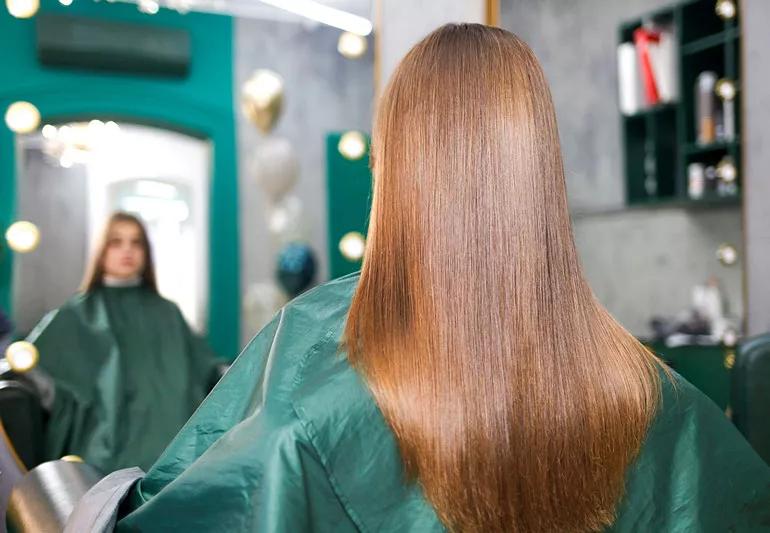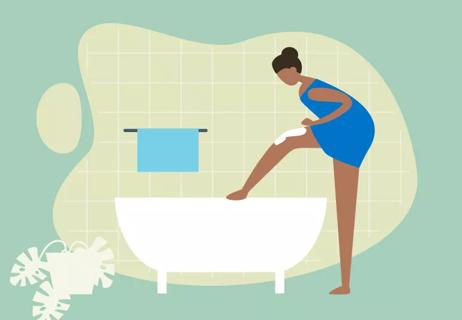The popular salon service aims to give you smooth, shiny, frizz-free hair

For those who lust after having smooth, frizz-free hair, you may have heard of keratin treatments — and maybe you’ve even tried the popular salon service.
Advertisement
Cleveland Clinic is a non-profit academic medical center. Advertising on our site helps support our mission. We do not endorse non-Cleveland Clinic products or services. Policy
A keratin treatment can reduce your blow-drying time, cut down on frizz, smooth your hair cuticle and amp up shine. But for some individuals, keratin treatments may damage your curl pattern and it can be an expensive and lengthy process.
Dermatologist Alok Vij, MD, explains what’s involved with a keratin treatment and if it’s something you should try.
Keratin is a type of protein that makes up the outer surface of your hair, skin and nails.
“As you age, you lose keratin. It gets broken down or becomes damaged,” explains Dr. Vij. “Overtime, factors like environmental triggers, UV chemicals and heat can break down keratin. Those factors basically cause the protein to change its natural shape.”
And as the shape and structure of keratin change, its function changes. “That means that your hair doesn’t have the same strength, elasticity or shine,” he continues.
That’s where a keratin hair treatment comes in. “Keratin treatments are a chemical process where the outer layer of the hair shaft is smoothed,” says Dr. Vij.
Keratin treatments can be used on any hair type. “People typically with longer hair or curly, frizzy hair may be more likely to use it,” he notes. “But even if you have short hair and you’re not happy with your hair’s volume, you can use the keratin treatment to make your hair look a little bit fuller and more lustrous.”
Advertisement
The process can vary at different salons, but typically, a hairstylist will start off by washing your hair twice with a clarifying shampoo.
After that, a keratin treatment or solution is applied to your wet hair and combed through. The solution will sit on your hair anywhere between two and four hours, depending on the amount of hair you have and its texture.
Finally, your hair stylist will dry your hair and then use a flat iron to seal the treatment into your hair. This step is key.
“The keratin treatment isn’t shampooed out. It coats your hair and it smooths everything out,” explains Dr. Vij. “And then the heat seals it, or cures it, to help restore that outer layer to a glossy, shiny, smooth texture.”
A keratin treatment before and after may surprise you with how sleek and shiny your hair is. And those results can last about six months if you don’t wash your hair too frequently.
Some pro tips? You want to wait a few days before your first shampoo after your keratin treatment and then try to cut down on the number of times you shampoo. And use sodium chloride-free hair products, which are free of harsh chemicals that can harm your hair.
Some keratin treatment formulas may contain formaldehyde, a strong-smelling chemical that can cause watery eyes, coughing, wheezing, skin irritation and a burning sensation in your eyes, nose and throat.
“Unfortunately, formaldehyde is in almost everything around us. It’s in soaps, shampoos and the foods that we eat,” says Dr. Vij. “Obviously, you don’t want to be putting that into your body in high quantities. So, if you can avoid exposure to formaldehyde, it can be helpful to maintain skin health and overall health. There are still questions about whether there are links to cancers and other negative effects on our overall health.”
While there are formaldehyde-free keratin treatments on the market, those formulas don’t work as well. So, make sure you do your research and weigh the pros and cons of a keratin treatment.
Keratin treatments aren’t recommended for individuals who are pregnant. And if you have sensitive skin or allergic contact dermatitis, you want to proceed with caution.
“Those individuals should just be careful,” stresses Dr. Vij. “You want to look for formulas that may be fragrance-free and preservative-free.”
You may also want to consider the cost of a keratin treatment. You can spend upwards of $300 per treatment.
At-home keratin treatment kits are available in stores and online that might work better for your budget. But it’s vital that you read through all the instructions beforehand and follow them closely.
Advertisement
“Make sure you clean your hair well with a nice shampoo. Apply the keratin treatment, let it soak in and then activate it with a heat source,” says Dr. Vij. “Professional heat sources may be more effective over a shorter amount of time.”
Advertisement
Learn more about our editorial process.
Advertisement

This old-school hair removal method is painless if done correctly — but it’s not for everybody

Most recommended precautions center around minimizing bruising or swelling

Even one drink can have an impact on your cognitive function leading to slurred speech, blurred vision and impaired memory

Understand who may (and may not) benefit

Lorem ipsum dolor sit amet. Et odio Quis vel ipsam omnis eum alias deleniti et placeat impedit non voluptas galisum hic autem enim et cupiditate aliquid. Est beatae quidem non facilis autem ut commodi nisi aut tempore rerum et dolores voluptatem cum enim optio id sapiente quasi. Ad laboriosam officiis 33 cupiditate sequi ea voluptatum consectetur qui necessitatibus voluptate et quasi doloremque et facere explicabo quo explicabo officia

Seeking help through therapy can be an important step in improving your quality of life when you have UC

Type 2 diabetes isn’t inevitable with these dietary changes

Applying a hot or cold compress can help with pain